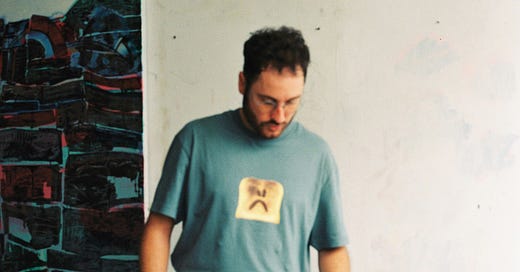Xavi Ceerre Makes Deliciously Decayed Paintings
I can’t count the amount of times I’ve zoomed in and out of Xavi Ceerre’s paintings on Instagram. I’ve been following his work for a few years and was always curious how he makes his fragmented marks. I particularly love how his works evoke old city walls that have been battered by the weather. In my own work I explore a similarly decayed quality so I knew we had some things in common.
There’s something beautiful about art that makes you hyper-sensitive to your surroundings. Art that makes you appreciate the layers of peeling paint on a wall, or the faded text on a sign for a business that no longer exists. Not only do artists like Xavi walk through the world obsessing over these small details, they pass this enjoyment onto the viewer. It’s a never-ending feedback loop: the more you look at this type of art the more sensitive you become to noticing subtleties in your world. It’s about the fun of walking and looking and paying attention.
There are thousands of ways to create work by erasing and ‘decaying’. And part of whittling down those thousands of decisions is what makes your work your own. I reached out to Xavi, who lives and works in Barcelona, to find out more about the parallels between his work and old walls; I wanted to get an idea of how he makes his work his own.
Hey Xavi. So you’re based in Barcelona but have lived in New York. How do the cities compare in terms of making work?
I almost don't remember anymore. It was a different time when I was working in New York. I'd tell you that you take things more seriously there, but I'd be lying to you. Even if I lived in the middle of the desert and drew with sand I would take it the same way.
How would you describe your painting process? It looks like a lot of layers, like you paint over details?
My process is very organic and I don't think I follow a clear formula, although there are some mechanics. For example, at a certain point, there’s an area of the painting that I like and I say to myself: “Okay, this part is done”, and I try to continue working on the rest. However, that part ends up conditioning the rest of the painting and prevents me from moving forward, because I try to make everything relate to it. Over time I’ve realized that removing that part makes everything move forward.
Can you talk about the influence of the urban environment on your work? I can see some parallels with old walls, eroded surfaces and faded man-made marks.
Much of my inspiration comes from my walks. I see textures, shapes and colors. Old walls have always caught my attention. Like when the paint begins to peel off and old advertisements, signs, colors or graffiti appear.
The marks you speak of tell me stories. They are genuine images. It's a different way of consuming images. They are much more tied to a space and a moment. You can create a relationship with them.
I’ve also noticed there are never blocks of uniform colour, but more like layers that have melted into each other like the paint has broken down or weathered.
I like the idea of something being born spontaneously from the cooperation of several hands at different times. This happens a lot around us. I see it on different surfaces. It's as if there are forces acting in both directions, order and chaos, and there’s a dialogue between them.
What do you do when you get stuck with a painting and you’re not sure what it needs?
Go to the next painting. Rotate it. Turn it around. Go for a walk. Have a drink. Flip through a book. Cross out a part. Talk to someone. Get some sleep. Look at the painting from the floor. Make some sketches. Forget about it for a while...
What do you do when you’re not painting? Do you have other interests or obsessions?
I'm an enthusiast. I experiment with electronic music production and I'm interested in things like archeology, programming and web brutalism, philosophy, photography, sound design, animation or video games. I also collect records, books, synthesizers, old magazines, comics and fanzines. I’m interested in pretty much anything that someone is able to talk to me passionately about.
What’s the current Barcelona art scene like in terms of galleries and artists?
Invivible pero insustituible [unliveable but irreplaceable].
Follow Xavi on Instagram: @xaviceerre
Things on Our Radar This Week
An excerpt from the new documentary, The New School of Paris, highlighting stories of female gallerists and critics who contributed to the rise of post-war European abstraction
A fantastic lineup of the world’s best collage artists in this show in Valladolid, Spain (until 7 July)
Rita Ackermann’s gorgeous looking show “Splits” at Hauser & Wirth NYC (until 22 July)
Maite y Manuel just opened their latest show at Alzueta Gallery Turó in Barcelona
Joe Bradley discusses his latest group of paintings on show at David Zwirner NYC
Amar Gallery is reopening in London’s Fitzrovia and champions historically overlooked female and minority artists
Thanks for reading, see you next week!
Oliver & Kezia xx
Palette Talk is free and we hope to grow with your support. If you’ve enjoyed reading, drop us a donation via PayPal…









